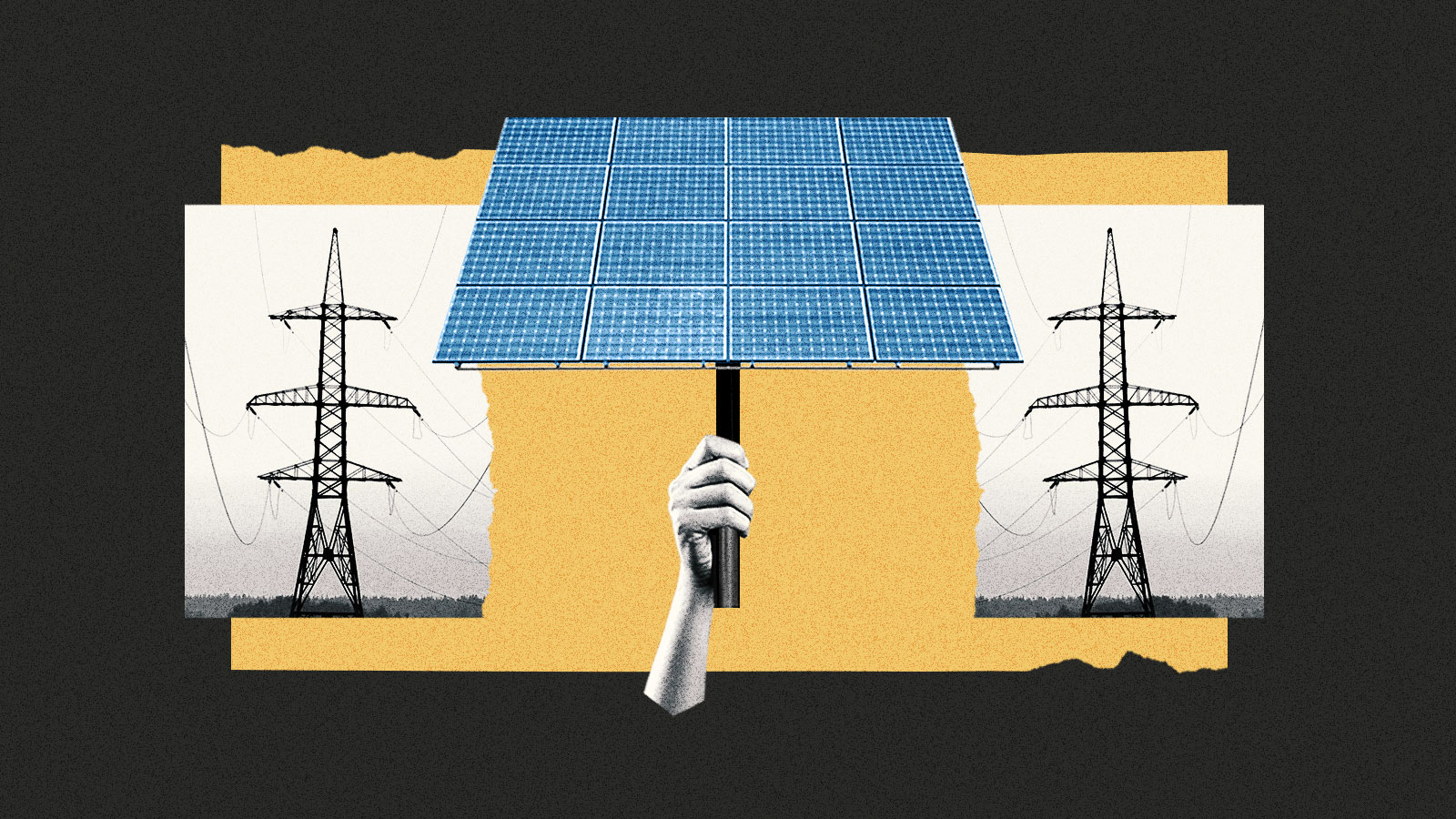This story was produced by Grist and is co-published with WBUR.
At the end of October 2017, a severe windstorm swept through the state of Maine, felling trees, knocking down power lines, and wiping out electricity for nearly half a million people. Larissa Smith, a longtime Maine resident who was living in Freeport at the time, lost power at her home for nearly three weeks.
That’s why she was surprised when, a few weeks later, she received a monthly bill from her utility company, Central Maine Power, or CMP, charging her close to $200 for electricity usage.
“I called CMP, and I’m like, ‘How are you even charging me at all?” she recalled. “I didn’t have power; I just don’t know how that’s possible.” The bill was at least $70 higher than any she had received within the past year. She called CMP’s customer service multiple times and asked them to send someone to check her electric meters. No one would help. “They just kept saying, ‘You’ve got to pay your bill, or we’ll shut off your power,’” Smith said.
She eventually paid off the bill, but her misgivings with CMP continue to this day. Smith and her partner recently installed a heat pump in their home, hoping to replace their broken oil burner with a climate-friendly technology. But after the state authorized a 49 percent increase in electric supply rates in January, driven by rising costs of natural gas, her electric bills have spiked from around $100 to $200 a month to as high as $1,000. The added financial burden has led Smith, who works in the IT sector, to take on more work to pay for home insulation and defray her electric costs.
“I don’t trust CMP,” she said, reflecting on her experiences. (CMP declined to comment on Smith’s experience, citing public utility commission policies.)
Stories like Smith’s are common in Maine. Smith is one of an estimated 297,000 customers, or around 21 percent of Maine’s population, who saw their electricity costs soar after a new billing system was introduced by the investor-owned utility in 2017. In 2020, the company was fined $10 million by the state’s Public Utilities Commission for its mishandling of billing and customer service complaints starting in 2016.
CMP and Versant, a smaller investor-owned utility, distribute 97 percent of Maine’s electricity. Over the years, CMP has come under fire for unexplained billing increases, unwarranted disconnection notices, and delays in connecting new solar projects to the power grid. Both companies have been criticized for unaffordable rates, poor customer service, and prolonged outages during storms. According to the market research company J.D. Power and Associates, CMP and Versant ranked lowest in customer satisfaction among large and midsize electric utilities, respectively, in the eastern United States last year.
Now, a historic referendum could spell the end of both utilities. On Tuesday, Question 3 on Maine’s ballot will ask voters to decide whether they want to oust CMP and Versant and replace them with a nonprofit, publicly owned utility called Pine Tree Power. The proposed utility would buy out the existing utilities’ infrastructure using revenue bonds and be governed by a board made up of elected officials and appointed experts. While a public takeover of the power grid has happened before at the local level in places like Winter Park, Florida, and Jefferson County, Washington, Maine’s referendum is the largest effort in decades, and the first-ever push for a statewide public power company.
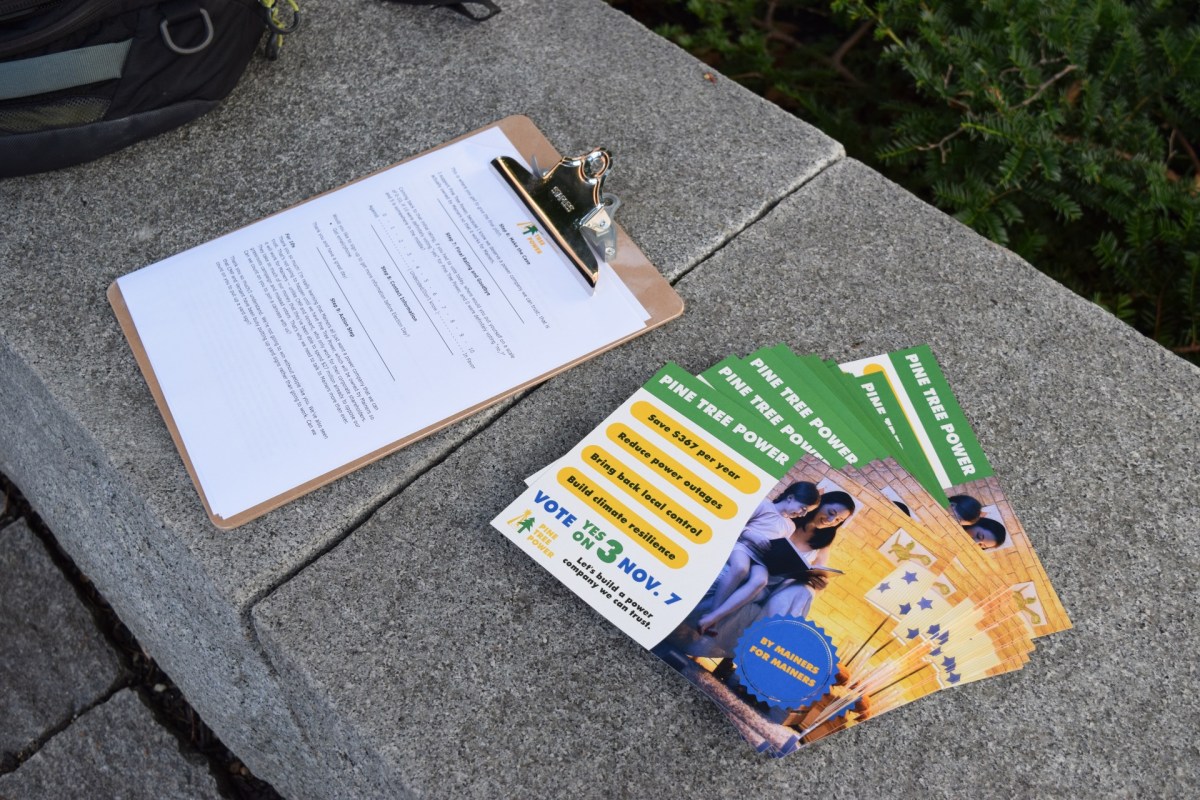
It likely won’t be the last. As communities around the country lament soaring electricity rates, dangerous blackouts, and a frustratingly slow transition to renewables, more and more people are considering a public alternative to investor-owned utilities, which currently serve three-quarters of customers in the U.S. From San Diego to Rochester, New York; Santa Fe, New Mexico, to Ann Arbor, Michigan; and the District of Columbia to Decorah, Iowa; advocates in a growing public power movement say that energy should be reliable, affordable, and accountable to the people using it. They argue only a publicly owned and managed electric grid can rise to the challenge of climate change by providing renewable power as a public good and serving the needs and interests of the people using it, rather than shareholders.
“It certainly feels like there is a growing consensus around public ownership,” said Sarahana Shrestha, a member of the New York State Assembly. Her office is currently exploring public power for her district and is closely following Maine’s vote.
CMP and Versant have poured tens of millions of dollars into efforts to oppose the ballot measure, but their opposition isn’t the only obstacle. Even if Maine votes yes, a public power transformation won’t happen immediately. It will take years for Pine Tree Power to repair or replace the aging infrastructure affecting reliability and impeding Maine’s clean energy goals. And before getting to that point, utilities are likely to put up a potentially lengthy and costly legal fight.
As of October, a poll commissioned by the Climate and Community Project, a progressive nonprofit that supports public power, found Maine voters evenly split with 37 percent in favor of Pine Tree Power, 37 percent against, and about 25 percent undecided. Another poll by the University of New Hampshire pointed to 31 percent in favor and 56 percent against. Many residents have their fair share of unanswered questions, and some want a level of assurance and certainty on their rates under a new utility that’s impossible to provide. Whether they believe that public ownership could make affordable, clean, and reliable electricity possible — and whether taking that leap of faith is worth the potential risks — is the question that will determine Maine’s energy future.
On a cloudless, sunny day in Brunswick in September, Seth Berry, a former member of the Maine House of Representatives, sat on a picnic bench outside a local coffee shop, scrolling through old voicemails from constituents dealing with utility bills from CMP they couldn’t afford.
One woman living on Social Security in the town of Harpswell was facing a $379 monthly bill that occasionally shot up to over $700 with no explanation. “I’m kind of desperate,” she told Berry. Another woman in Harpswell was being charged $90 a month from CMP while living in a 40-square-foot apartment.
A state report last year found that ratepayers in Maine at or below the federal poverty level spend a quarter of their income on their utility bills. Disgruntled customers have taken to sharing their concerns in a Facebook group with over 2,400 members called CMP Ratepayers Unite.
Representatives from CMP and Versant told Grist that while they acknowledge customers are struggling to pay their bills, neither company controls nor profits from power supply costs, which are driven by underlying energy prices and make up close to 60 percent of an electric bill. Versant spokesperson Judy Long noted that the company launched a program last year to provide direct assistance to ratepayers in need. She also pointed to Versant’s own polling, which found that two-thirds of its customers are satisfied with their service. CMP spokesperson Jonathan Breed did not respond directly to questions about customer service, but he noted that since 2018, the company has invested $3 billion to improve Maine’s grid.
Berry wanted to help folks like his constituents in Harpswell — which is why, in 2019, he introduced a bill to create a public power authority for Maine. He cites saving people money and making energy more affordable as his main reasons. But he also knows that decarbonizing Maine’s economy, and transitioning fossil-fuel dependent sectors like transportation and heating to renewable energy, will require huge investments to expand the capacity of Maine’s power grid. That’s an effort that he described investor-owned utilities like CMP and Versant as directly impeding.
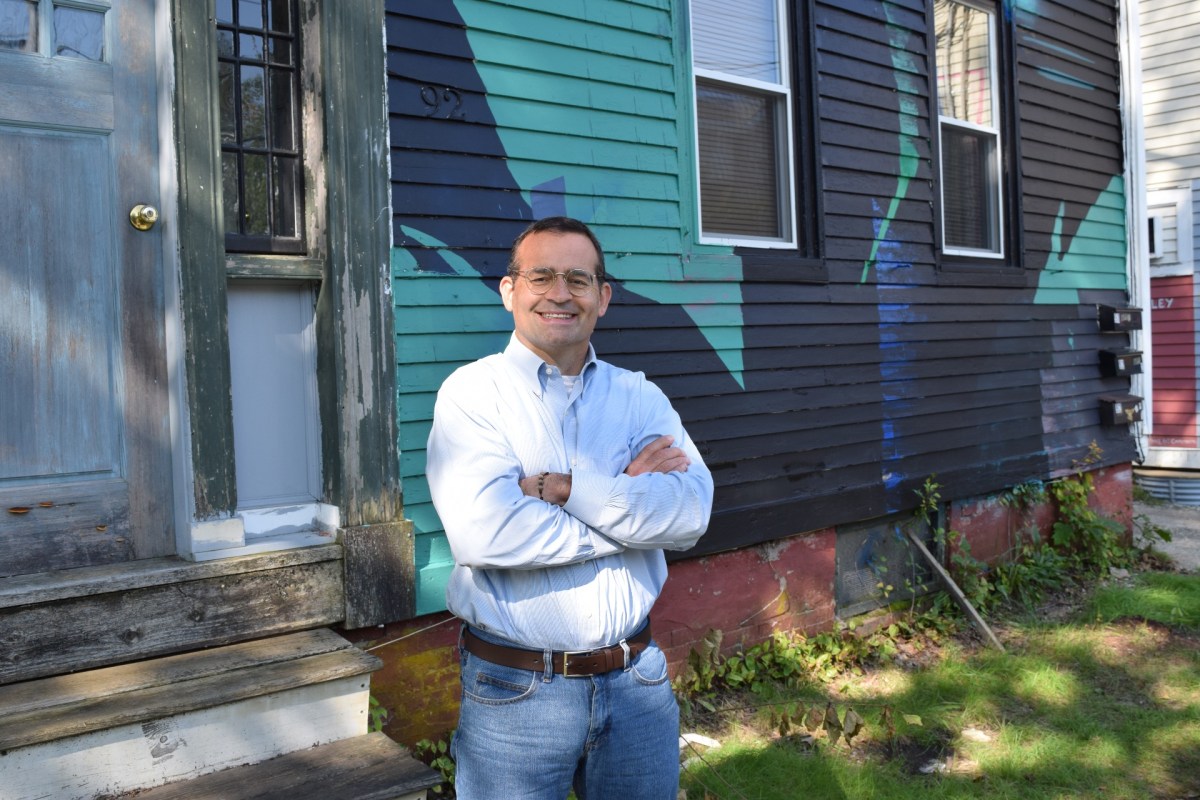
In 2017, CMP successfully lobbied state legislators to strike down a net-metering law in Maine that would have allowed households with rooftop solar to earn money for the electricity they add back into the grid. Solar developers in Maine have also accused CMP of causing unexpected delays in connecting their projects to the grid, at times requiring multimillion dollar infrastructure upgrades at the last minute. In January 2022, after a series of investigations by the state’s Public Utilities Commission, clean energy trade groups and CMP reached a settlement that would require the utility to spend $700,000 to hire more staff to speed up the interconnection process and troubleshoot further issues.
But CMP and Versant argue they’ve supported this work in other ways. Breed noted that CMP supported a different solar law that passed in 2019, which subsidized construction of new farms and led to a boom of solar projects in Maine. He said CMP quickly adapted to the influx of project applications and is on track to install 500 megawatts of solar since the bill’s passage. Long told Grist that despite being a relatively small utility, Versant has worked with developers to connect more solar and other renewable power than needed to meet current energy demand.
When Berry started looking for potential alternatives to Maine’s investor-owned utilities, he didn’t have to look far. Nine consumer-owned utilities like Kennebunk Light and Power District and Houlton Water Company already exist in the state, typically serving smaller, more rural areas. Across the country, about 2,000 consumer-owned electric utilities serve more than 49 million customers, in places including Sacramento, Long Island, Seattle, and the entire state of Nebraska, which has had public power since the 1930s.
Unlike investor-owned utilities, publicly owned utilities typically don’t operate at a profit, and they don’t pay dividends to shareholders. They’re often governed by an elected or appointed board of citizens from the region they serve, offering a model of local ownership and democratic governance that, to Berry, seemed like an obvious fit for Maine. According to the U.S. Energy Information Administration, public utility customers experience more reliable service, with an average of one hour of interrupted service each year compared to about two hours experienced by investor-owned utility customers. The average household also pays about $15 less per month using a publicly owned utility compared to an investor-owned utility. And while both public and private utilities continue to rely heavily on fossil fuels, Berry says it’s no coincidence that several public utilities, from Rock Port, Missouri, to Greensburg, Kansas, were among the first to be powered by 100 percent renewable energy.
“If we’re going to decarbonize, it’s not enough to have it be clean. It also has to be affordable. It has to be reliable. The power can’t be going out all the time like it is here,” Berry said. “All of this is possible. It’s happening right here in our state. Why don’t we all do this?”
Despite popular support, Berry’s initial bill died in committee. But the legislature commissioned an independent study released in 2020 to evaluate the economic feasibility of the proposed public power authority. In 2021, after fine-tuning the bill’s language with input from the study, utility experts, labor lawyers, and climate policymakers, Berry helped reintroduce a second version of the bill with a Republican state senator, Rick Bennett, as lead co-sponsor. The proposal passed both chambers — the first time a legislature has voted to buy out a state’s privately owned utilities.
But the victory was short-lived. Governor Janet Mills, a Democrat, vetoed the measure, calling the proposal “hastily drafted and hastily amended” and “a patchwork of political promises rather than a methodical reformation of Maine’s complicated electricity transmission and distribution systems.”
After the governor’s veto, Berry and an advocacy group formed to support his bill, Our Power, shifted their attention to collecting signatures to get a slightly tweaked version of the bill on the next ballot as a citizens initiative. (Berry decided not to run for reelection in 2022 to focus on this campaign.) The process allows legislation in Maine to bypass the legislature to head straight to voters as a referendum if the measure receives over 63,000 signatures.
Jonathan Fulford, a former state senate candidate and a co-founder of the Our Power group, says he always knew that the proposal would come down to a citizens initiative, for the simple reason that the idea was likely too radical for state policymakers.
“It’s much harder, I think, to get public officials to be willing to support something that is challenging an established structure, than to get people who are average citizens saying, ‘This isn’t working — I’m not happy about this. What the hell, let’s change it,’” he said in September, looking out at the harbor in the seaside town of Belfast.
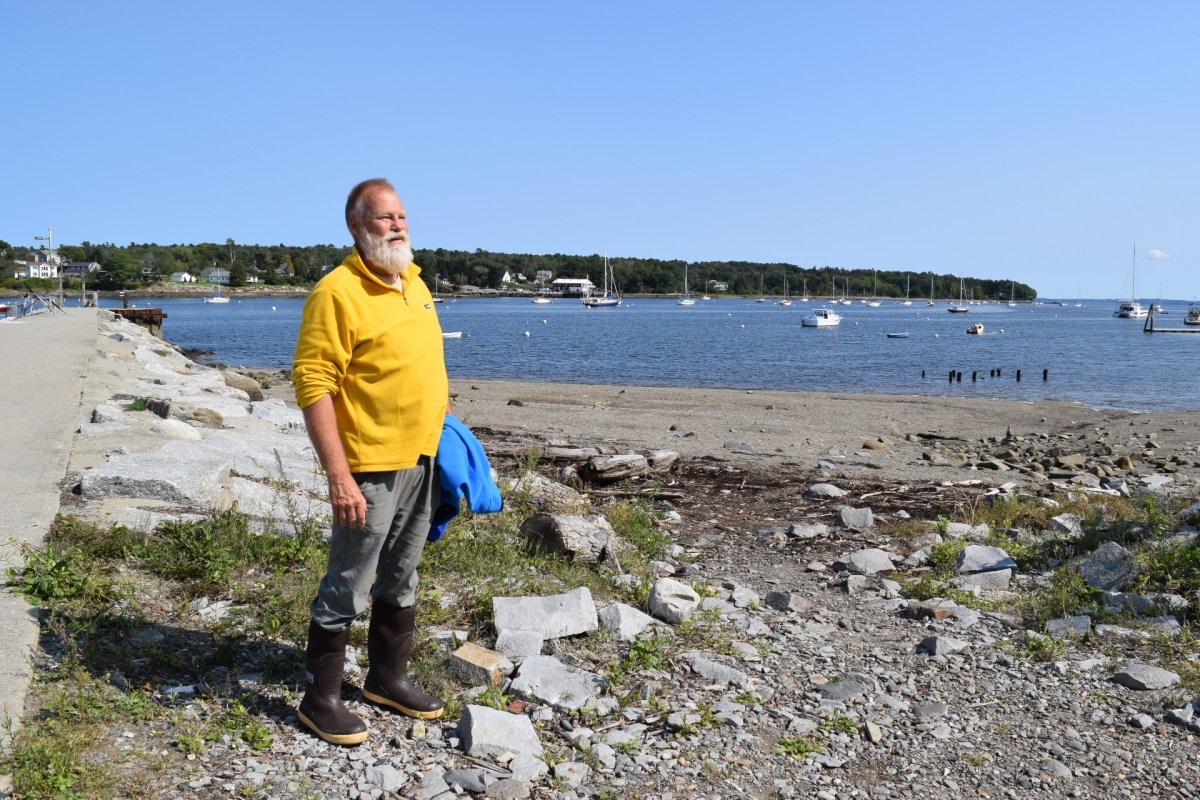
Leaning on a grassroots network that Fulford helped assemble to support Berry’s bill, Our Power collected over 80,000 signatures from October 2021 to October 2022. “Collecting signatures was easy, but listening to people’s horror stories about their experiences with CMP was heartbreaking,” one retired teacher and activist told a local outlet. That November, public power supporters filed into the Maine secretary of state’s office, carrying cardboard boxes full of petitions. On November 30, close to 70,000 of those signatures were found valid by a state bureau. The referendum was officially headed to Mainers for a vote this fall.
This time, Fulford said, the stakes are different. Convincing voters to agree to put a question on the ballot is one matter. Actually getting them to take a leap of faith on a nonexistent public utility, and defy a multimillion dollar campaign to stick with the status quo, will be a true test for Our Power’s grassroots advocacy.
“Now you have to educate people so that when the attack ads and disinformation campaign gets going, they are resilient enough to stick with why this makes sense for them to vote for it,” Fulford said. “That’s a whole nother campaign.”
On a golden late afternoon in September, five student volunteers for Our Power gathered by a polar bear statue on the campus of Bowdoin College in Brunswick. They were being trained to speak to voters about the Pine Tree Power referendum in a nearby residential area. Lucy Hochschartner, the deputy campaign manager for Our Power, explained to the students that this wasn’t your typical canvassing, where door-knockers try to persuade voters in a one- or two-minute chat.
Instead, they were going to use an approach called deep canvassing, a strategy she described as “getting the voter to actually share their story with you and connect on values, and persuade themselves.” Those in-depth conversations, Hochschartner said as she walked along a shady street lined with colonial-style houses, are her favorite part of her job. They’re also central to Our Power’s plan to win the election.
“How do you feel when you open your utility bill every month?” she asked one resident, who leaned over their porch railing to talk to the canvassers. A large, fluffy white dog bounded to their side, holding a reindeer plushie in its mouth. Just to the left, chickens pecked behind a wooden gate.
“They’re very high. I hate CMP,” they responded, setting down some grocery bags they were just about to carry in. “Watching the ads really made me angry.”
Almost every resident the canvassers spoke to that day had seen, heard, or read the opposition campaign’s ads, which circulate on TV, radio, mailed flyers, Facebook, and other social media. “Pine Tree Power is a risk Mainers can’t afford,” one YouTube ad says.
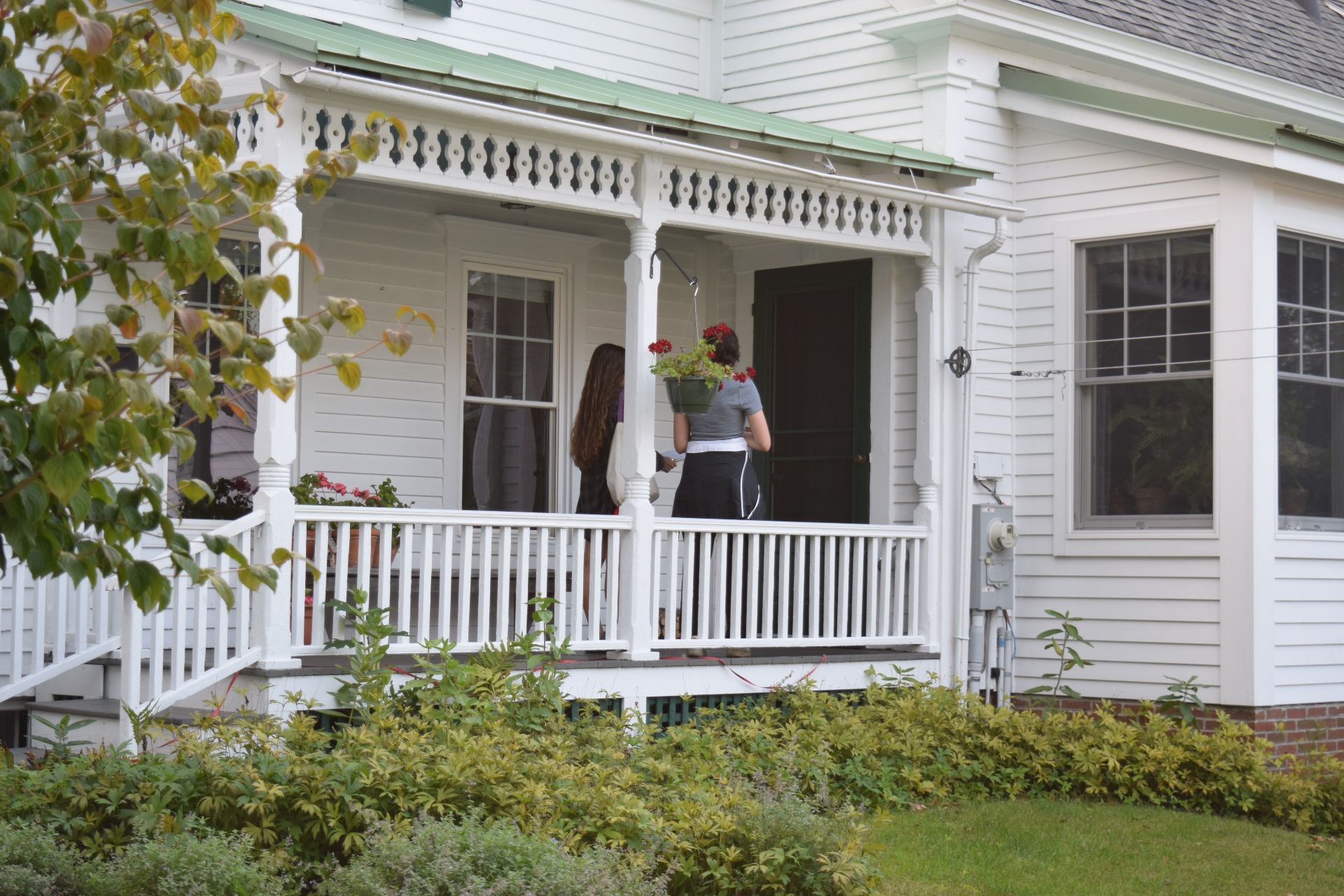
Lucy Hochschartner, deputy campaign manager for Our Power, trains Bowdoin College students before canvassing in Brunswick, Maine. Akielly Hu / Grist
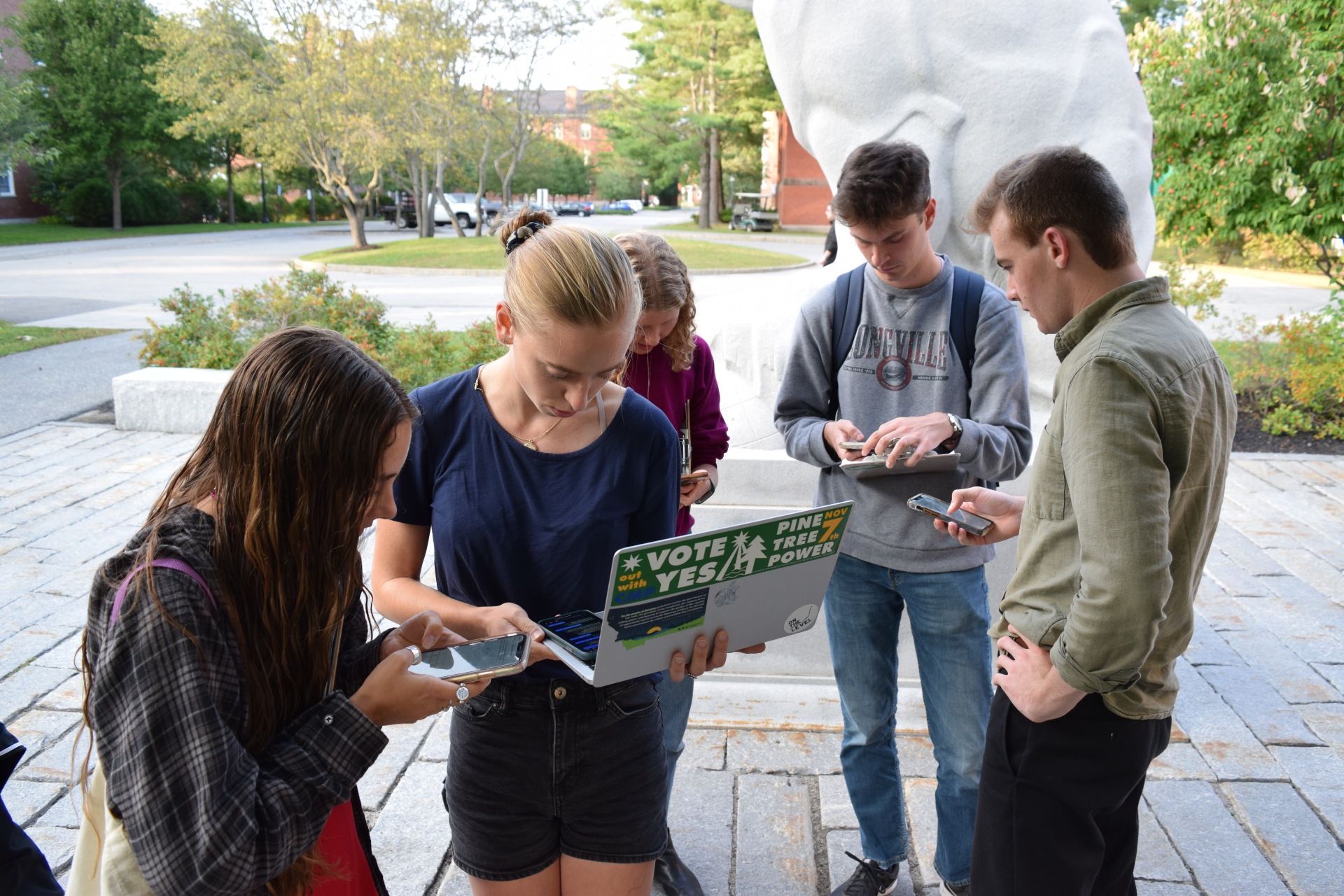
According to the Maine Ethics Commission, a state agency that tracks campaign finance, three political groups opposed to the Pine Tree Power referendum have spent about $39 million combined on advertising, personnel, polling, and other campaign activities. Maine Affordable Energy is funded almost exclusively by CMP and its parent company, Avangrid. The committee has received nearly $24 million from those utilities. Maine Energy Progress, which is exclusively funded by Enmax, the parent corporation of Versant, has received more than $16 million to date. Another committee called No Blank Checks, funded by Avangrid and CMP with more than $1.3 million, is pushing for a separate ballot question to prevent public utilities like Pine Tree Power from borrowing more than $1 billion without statewide voter approval. Combined, the utilities’ ballot opposition funding is more than 34 times higher than that of Our Power, which has received roughly $1.2 million to date from 2,200 unique donors, according to the group.
The utilities have good reason to pour money and effort into the campaign. If Pine Tree Power successfully forms, CMP and Versant, both of which operate exclusively in Maine, will likely go out of business. A June investigation by the Portland Press Herald and Floodlight News found that Maine Affordable Energy has paid three former state legislators to advocate against the referendum, including through op-eds and speaking on public forums. As of June, the committee had also paid $5 million to the Democratic political consulting firm Left Hook and $690,000 to Global Strategy Group, a polling firm that last year was contracted by Amazon to bust union organizing at a warehouse in Staten Island, New York.
Sitting in his committee’s office in downtown Portland, Willy Ritch, director of Maine Affordable Energy, said his campaign reflects “concerns we hear from voters all over the state,” through participating in forums, tabling at events and festivals, and canvassing.
By far the biggest concern, Ritch says, is the cost of buying out the utilities — a cost that will eventually be borne by ratepayers. “You just can’t get past that huge debt that Pine Tree Power would start with,” he said.
If approved, the new public utility would need to first buy all the existing poles and wires that CMP and Versant use to deliver power to millions of customers. (CMP and Versant don’t generate their own electricity, and instead purchase power supply from a wholesale regional market.) The exact price of those assets would be negotiated through a multistep court process, with the ultimate cost likely determined by a court-appointed referee. Once a price is settled, Pine Tree Power would purchase the infrastructure using utility revenue bonds, a type of loan commonly used by local governments and paid back through the utility’s future revenues.
The cost of the takeover has been heavily disputed. According to recent financial reports submitted to the Federal Energy Regulatory Commission, the value of CMP’s grid infrastructure is close to $4.2 billion, and Versant’s is worth about $1.3 billion. But given legal precedents in how utility companies are bought and sold, Pine Tree Power would likely need to buy the utilities’ assets at a premium. The study commissioned by the Maine state legislature estimates that the final price will likely be 1.5 times the assets’ underlying value, citing the premium paid when Enmax acquired Versant in 2020.
That would equal an acquisition cost of roughly $8.25 billion, although that number could fluctuate as assets wear out over time, or as any upgrades or additions are made to the grid. Our Power says that the Pine Tree Power board will negotiate as low a premium as possible, while the opposition estimates a cost of $13.5 billion, a number that is featured prominently in almost all of Maine Affordable Energy’s ads. That’s because analysts contracted by CMP’s parent company estimated a later purchasing date of 2030 and a multiplier of 2 instead of 1.5.
Ursula Schryver of the American Public Power Association, an industry group representing consumer-owned utilities, says the real number will likely end up somewhere in the middle. But she emphasized that the debt will be paid off incrementally through revenues over a period of decades, not all at once. She also stressed that once the state owns the power grid, it becomes a financial asset. “It’s kind of like when you buy a house. You may spend a lot more on buying a house than when you rent it, but you own that house forever,” she said. “It’s important to look at that as an investment, versus just a cost.”
Maine Affordable Energy, on the other hand, maintains that the burden of the initial debt will fall onto consumers and result in higher electricity rates. “Somebody’s gotta pay it back, right? And the only people that can pay it back is us, the ratepayers,” Ritch said.
For some Mainers, the lack of certainty on what their rates will end up being under a new public utility is a legitimate concern. One resident in Brunswick wondered how they could know for sure that their rates would go down.
“On a fixed income, one wants to be sure that you’re getting a better deal than you’re getting at the moment,” they said.
Whether the public takeover of CMP and Versant would raise or lower customers’ bills is highly contested. The study commissioned by the Maine legislature projected that, in part due to the initial cost of buying out incumbent utilities, electric rates under a public utility could be higher in the first decade of operation. After 10 years, rates would then continuously go down, largely because public utilities have access to tax-exempt financing. Our Power activists point to another analysis conducted by an economist based in Maine, which adjusted the independent study’s model and found that ratepayer savings would begin immediately and add up to a cumulative $858 million over 30 years.
Kenneth Colburn, a former director at the Regulatory Assistance Project, an energy policy nonprofit, says he doesn’t think either estimate is credible, owing to missing factors like technological advances, energy demand management, and energy efficiency improvements. Even so, he sees a stronger financial argument for a publicly run utility because of the lack of a profit incentive.
Investor-owned utilities typically earn money by receiving a return on their capital investments. When CMP or Versant spend money to upgrade the grid or build infrastructure, the state public utilities commission authorizes them to seek a roughly 9 percent rate of return on those investments. That added cost is passed down to consumers in the form of higher rates.
Publicly owned utilities, on the other hand, don’t require a return on investment. They also don’t need to pass on profits to shareholders — “one less slice of the pie that ratepayers have to pay for,” as Colburn put it.
They can also borrow money at a lower interest rate using tax-exempt revenue bonds, putting them at a major advantage for making the investments needed to expand the capacity of Maine’s power grid, Colburn said.
To get to that point, however, Pine Tree Power would first face an uphill legal battle against the legacy utilities. Ritch argues that the ensuing litigation and bureaucratic delays involved in buying out the utilities would take up to 10 years to resolve, a timeline often repeated in the opposition’s ads. “It’d be such a huge change to our economy. There would inevitably be a lot of disagreement and fighting legal battles over that,” Ritch said.
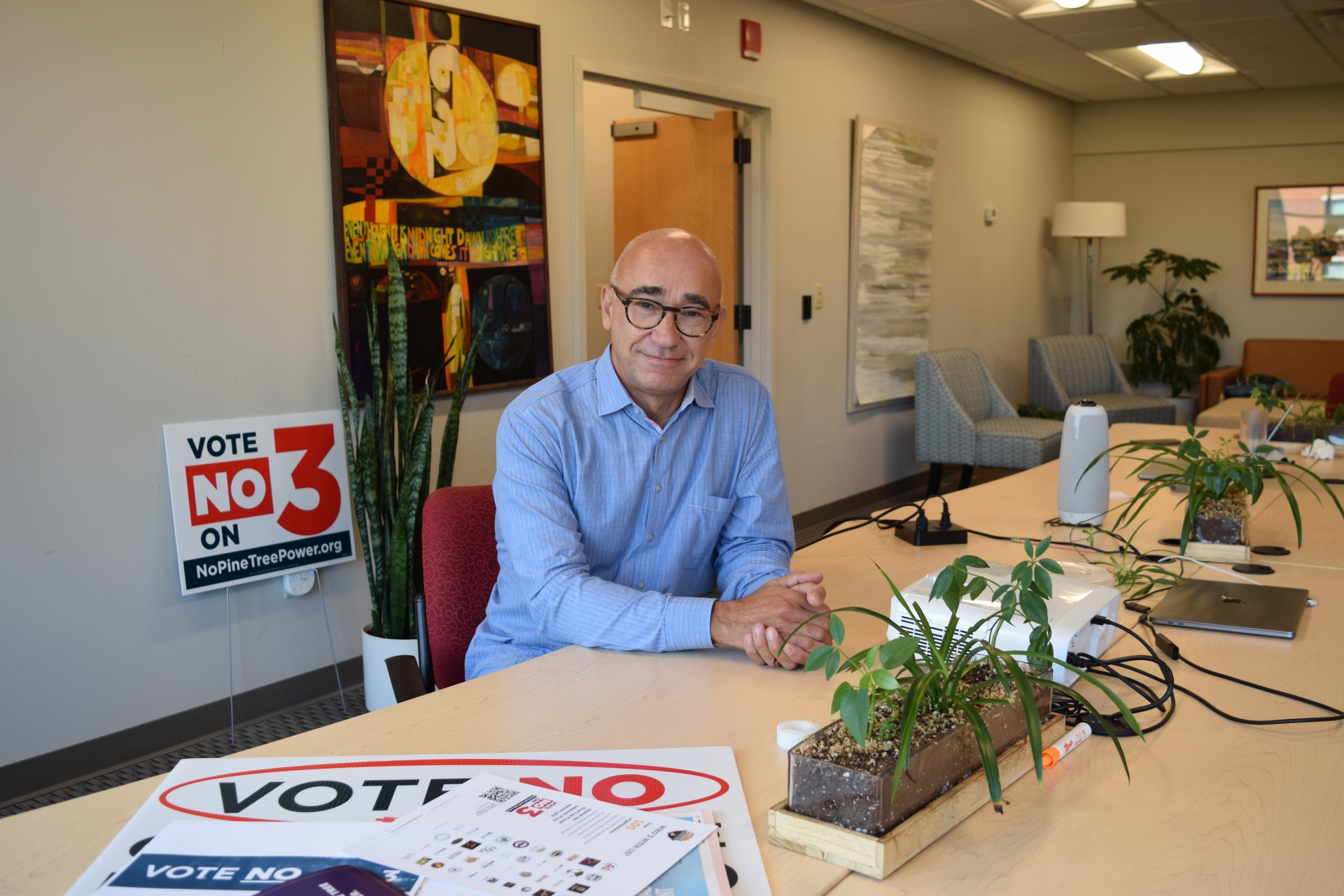
Those legal challenges would be initiated by the investor-owned utilities themselves. The study commissioned by the Maine legislature found that a public takeover of the utilities would be fully constitutional. The bill itself sets deadlines for how long the investor-owned utilities have to negotiate a price, and Our Power expects that resolving any legal conflicts will take at most three to four years. CMP and Versant were reluctant to comment on any specific litigation plans, but there’s little doubt from both sides of the campaign that the utilities, with a combined $187 million in profits last year alone, will inevitably throw their resources behind challenging a buyout and disputing any selling price in the courts.
“If we win, they’ll sue the next day,” Fulford, the Our Power co-founder, said.
Schryver at the American Public Power Association says that the threat of litigation is a scare tactic often used by utilities during a public power takeover. “The investor-owned utilities will always say that they are going to go to court, they will fight it,” she said. “And their goal is to scare these communities into not moving forward.”
But these aren’t empty threats. Litigation was one reason why a decade-long campaign for public power in Boulder, Colorado, eventually folded in 2020. Existing utilities, Schryver says, are usually not willing sellers, and having to finance those legal battles might add unexpected costs that could ultimately fall on ratepayers. “It’s a very costly process both in terms of time and money,” she said. “Communities have to be prepared for that.”
Grist asked representatives at CMP and Versant if they plan to respond to concerns Maine residents have raised around affordability, reliability, and climate action, regardless of the outcome of the election. “We are up to the challenge of meeting service metrics that are aligned with our customers’ needs, as we have proven over the last several years, and we will continue to be mindful that our service must remain affordable for our customers,” Long at Versant said. Breed at CMP said the company “strongly supports Maine’s clean energy transition” and state climate goals and “will always look to seek a fair and balanced compromise on policies that continue to build on the environmental progress already made while not overburdening our customers, especially those who are already struggling to pay their bills.”
Ritch at Maine Affordable Energy had a more straightforward response to whether CMP and Versant will address customers’ concerns if the referendum fails. The question, he said, was a nonstarter. Increases in electric rates are largely due to spikes in energy supply costs, mostly driven by the rise in natural gas prices, he said. He pointed out that Maine already has a lot of clean energy; according to the U.S. Energy Information Administration, about three-quarters of electricity generated in Maine comes from renewable sources like hydropower and wind. And when it comes to reliability and other promises, Pine Tree Power “is totally empty of any guarantees,” Ritch said. It’s “unfair” to ask the investor-owned utilities to act on concerns raised by the Pine Tree Power campaign when Pine Tree Power hasn’t yet delivered on any promises, he said.
That’s a response that concerns Colburn, who sees this moment as critical for decarbonizing Maine’s power grid to have a shot at a livable future. He worries that the existing utilities are “dragging their feet” when it comes to climate policies. “I don’t see them aggressively approaching demand management. I don’t see them aggressively sourcing renewables. I don’t see them working hard to interconnect as much solar as they can,” Colburn said. Instead, he sees the legacy companies saying in response to clean energy policies: “Here’s obstacles. Here’s problems. Oh, boy, that’s going to cost you.”
CMP and Versant, he said, are displaying “reluctance to depart from the way we’ve always done it. And this is a time where departure is not only necessary, it’s possible.”
Walking into the fairgrounds of Common Ground, a festival held each September by the Maine Organic Farmers and Gardeners Association, feels like starting a leisurely hike. Trees on either side of a meandering dirt path were tinged with the beginnings of fall color. Couples, families, and groups of friends swarmed ahead, pausing to admire the compostable toilets set up along the way to the fair entrance.
The event is described as a “celebration of rural living,” befitting one of the country’s most rural states. Barn stalls held goats, horses, and cows of all different breeds, swatting away flies with their tails. A large dirt field showcased a horse-drawn plow tumbling up loose, dark earth. Just beyond rows of food vendors, the smell of hot vegetable oil from a french fry stand permeating the air, Our Power had set up two booths in a tent showcasing social and political advocacy groups at the weekend-long event.
In the same tent, in 2019, Fulford went around to all the groups’ tables and told them about the idea for a publicly owned utility — planting the seeds that would become Our Power. This year, he arrived before noon, warmly greeting old friends at different booths. “The grassroots organizing, in my mind, really started here,” he said.

At the Common Ground festival, Our Power set up two booths in a tent for social and political advocacy groups. Akielly Hu / Grist

Fairgoers’ opinions about the bill didn’t seem to adhere to party lines. Lee Parsons identifies as a “big Democrat,” while his parents are conservative. Supporting Pine Tree Power is one of the few things they can agree on, “which is really super, super rare,” he emphasized. His parents recently bought a $6,000 full-house generator because the power was taking so long to turn back on during outages, while Parsons and his partner have faced spiking electric bills.
“It’s really hard when nothing’s working out for the middle class, and your bill goes up 70 or 100 bucks,” he said. “It’s just ridiculous.”
But most voters at the fair told Grist they remain undecided. A significant number didn’t even know Pine Tree Power was on the ballot. While the majority seemed open to the idea, many simply wanted to learn more about the proposal — particularly how it would save money and improve reliability.
Our Power volunteers say it mostly boils down to the promise of local governance and ownership. A locally elected board, instead of a distant, overseas corporate entity, would be more accountable to the people of Maine, they told festivalgoers.
In the early afternoon, state Senator Nicole Grohoski gave a presentation on Pine Tree Power. She is one of the first people Seth Berry roped in to help with the initial legislation and campaign back in 2019. Grohoski is the type of politician who tends to immediately inspire confidence, coming off both poised and good-humored.
“Can anyone here name someone who serves on the CMP or Versant board?” she asked the 50 or so people gathered, sitting on folding chairs and squinting against the bright sun. No one raised their hand. “Do you know how to get in touch with them?” Again, no movement. “Do you think their email addresses are online? They are not. Mine, on the other hand, is, and so is my cell number,” she said. “That’s the difference between someone who’s working in the public’s best interest, who’s elected by the public, and someone that’s been put there because of their financial interests.”
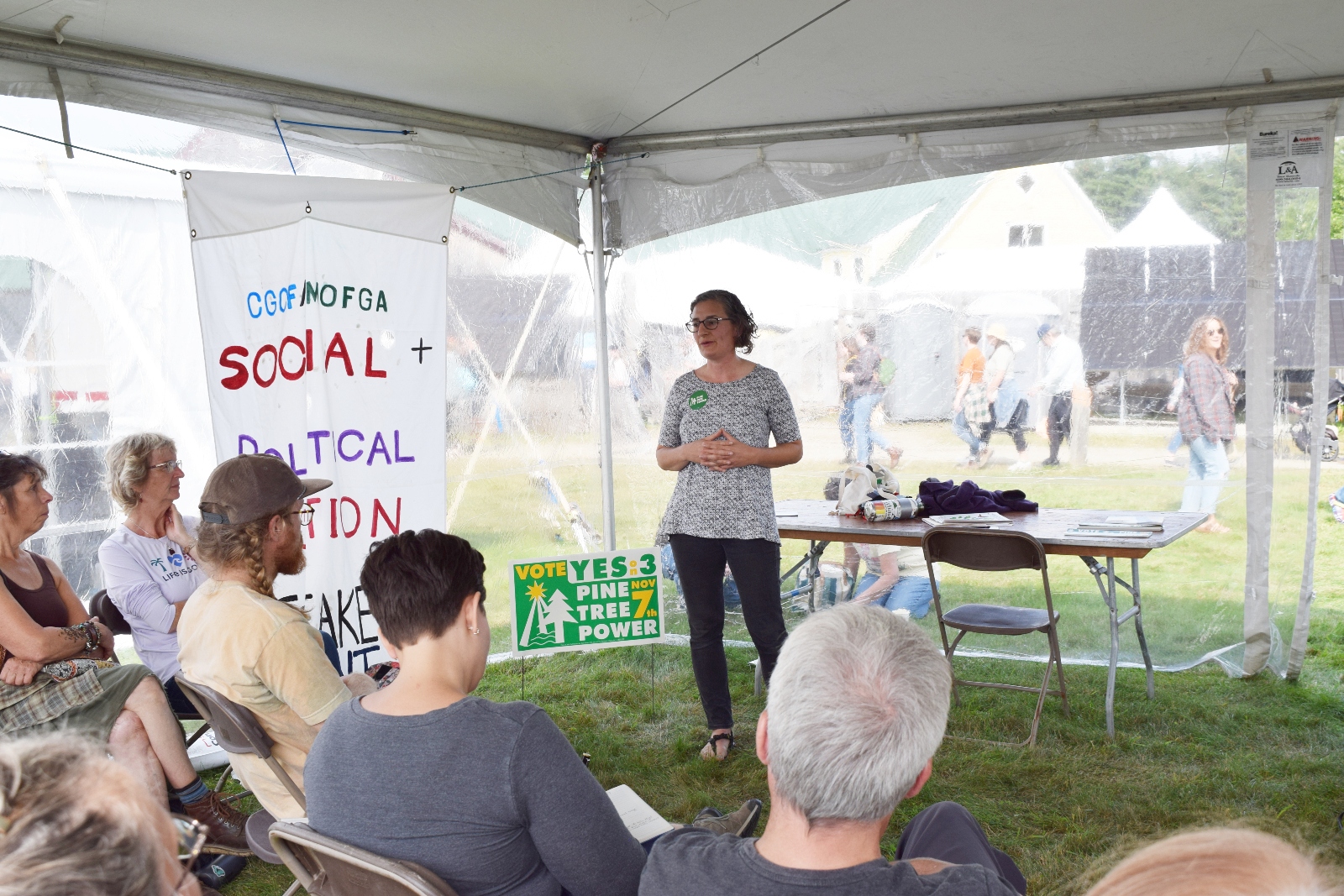
CMP and Versant, meanwhile, have framed the idea of local governance as introducing runaway partisanship and politicking into the state’s energy affairs, warning that Pine Tree Power would “put our electricity in the hands of politicians,” as one campaign ad argued. And while technically a contracted grid operator, not the elected board, will be managing the day-to-day operations of the network, it’s true that local governance is no guarantee of success. Publicly owned utilities, like private utilities, have been accused of setting unaffordable rates, lobbying to derail rooftop solar, and delaying the switch to renewable power.
It’s a nuance that voters are grappling with. “It’s a big change, and it’s a big chunk of change that’s gotta be spent up front,” said one fair attendee, Missy. “I’m still a little concerned about this committee — this board.”
But later, she and her family members, Jay and Erin, agreed they’ll likely vote for the referendum on November 7. “We know CMP is shady. They’re as shady as they come,” Jay said, expressing concerns over the utility’s construction of a transmission corridor through a densely forested area. “I’m so fed up with CMP and corporate-owned electricity that I’m willing to take a jab at this,” he added.
Missy shared her own frustrations with her high electric rates under CMP. “At this point, let’s take a chance, because it can’t get any worse right now.”
“I mean, don’t say that either,” Erin said, laughing.
“Well, no, you’re right, it could,” Missy said with a chuckle. “But at least it’s a step.”
By the time the fair closed for the day, the overcast sky was just starting to darken. The goats and sheep were being tucked back into their barns, resting comfortably on mounds of damp hay. At the exit, Seth Berry and Nicole Grohoski’s dad, both wearing bright green Pine Tree Power shirts, were handing out lawn signs that said “Vote Yes on Question 3!” to anyone who would take them.
The Our Power volunteers would be back at the fair all day the next day. Some vowed to keep campaigning for as long as it took to win.
“We could win this,” Berry said earlier. “But it’s also true that it could go the other way.”
To him, public power is always going to be worth pursuing, even if the referendum fails. In the past, referendums in Maine have failed and become resurrected later as bills passed through the legislature. Some referendums, like in the case of marriage equality, lost at the polls one year and won a few years later. “You’re never done” when it comes to democracy, Berry said. “Every single policy accomplishment, every single policy loss, can be reversed.”
As cars trickled out of the grassy parking lot, headlines beaming in the twilight, a few people walked to their cars with Pine Tree Power lawn signs.
Fulford knows that even if the referendum succeeds, there’s still a long road ahead for public power in Maine. “If it passes, we have a ton of work,” he said. “The opposition will not stop. They will pour all the resources they can, in every way that they can think of, to undermine this.”
The investor-owned utilities are terrified, he says, because Pine Tree Power doesn’t just threaten the existence of CMP and Versant. It could encourage other public power campaigns, already growing in number and popularity across the country, to follow suit. In late October, Our Power and five national and state climate groups hosted a weekend-long convening for public power activists from around the country. Around 60 advocates from the likes of California, Michigan, Montana, and New York gathered to share knowledge, connect their local movements, and learn from Maine’s experience.
“This would set a precedent that could echo across the entire country,” Fulford said.

